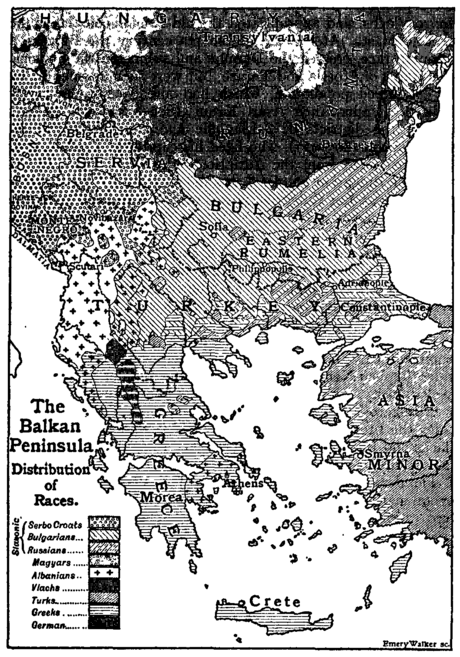present. The Eocene beds are folded, but the marginal Pliocene beds are not, and the final folding seems to have taken place during the Miocene period. (For the Balkans, see Bulgaria.)
Area and Population.—The following figures show the area and population of the various political divisions of the Balkan Peninsula in 1909; see also the articles on the separate countries.
| Political Divisions | Area in sq. m. | Pop. in 1909 | Pop. per sq. m. |
| Croatia-Slavonia (south of the Save and Kulpa) |
(about) 8,200 | (about) 1,200,000 | 146·3 |
| Servia | 18,782 | 2,493,770 | 132·2 |
| Bulgaria (with Eastern Rumelia) | 37,240 | 4,028,239 | 88· |
| The Dobrudja (Rumania) | 5,896 | 258,242 | 43·9 |
| Dalmatia (Austria) | 4,923 | 591,597 | 120·1 |
| Montenegro | 3,255 | 311,564 | 94 |
| Bosnia and Herzegovina (Austria-Hungary) | 19,696 | 1,568,092 | 70·9 |
| Sanjak of Novibazar (Turkish) | 2,840 | 153,000 | 53·5 |
| Albania, Macedonia and other Turkish possessions |
62,744 | 5,812,300 | 92·6 |
| Greece | 24,400 | 2,631,952 | 107·8 |
| 187,976 | 19,048,756 | 101·3 |
For full details as to the physical features, natural products, population, customs, trade, finance, government, religion, education, language, literature, antiquities, history, politics, &c., of the Balkan lands, see Albania, Bosnia and Herzegovina, Bulgaria, Croatia-Slavonia, Dalmatia, Dobrudja, Greece, Illyria, Macedonia, Montenegro, Novibazar, Servia and Turkey.

Races.—The Peninsula is inhabited by a great variety of races, whose ethnological limits are far from corresponding with the existing political boundaries. The Turkish population, descended in part from the Ottoman invaders of the 14th and 15th centuries, in part from colonists introduced at various epochs from Asia by the Turkish government, declined considerably during the 19th century, especially in the countries withdrawn from the sultan’s authority. It is diminishing in Thessaly; it has entirely disappeared in the rest of Greece, almost entirely in Servia; and it continues to decrease in Bulgaria notwithstanding the efforts of the authorities to check emigration. It is nowhere found in compact masses except in north-eastern Bulgaria and the region between Adrianople, the Black Sea and the Sea of Marmora. Elsewhere it appears in separate villages and isolated districts, or in the larger towns and their immediate neighbourhood. The total Turkish population of the Peninsula scarcely exceeds 1,800,000. The Slavonic population, including the Serbo-Croats and Bulgars, is by far the most numerous; its total aggregate exceeds 10,000,000. The majority of the Serbo-Croats left their homes among the Carpathians and settled in the Balkan Peninsula in the 7th century. The distinction between the Serbs of the more central region and the Croats of the north-west, was first drawn by the early Byzantine chroniclers, and was well established by the 12th century. It does not correspond with any valid linguistic or racial difference; but in the course of time a strong religious difference arose. Along the Croatian and Dalmatian coast there existed a well-developed Latin civilization, which was sustained by constant intercourse with Italy; and, under its influence, the Serbo-Croatian immigrants were converted to the Roman Catholic Church. In the wild and mountainous interior, however, the Byzantine Church had few or no rivals and the Orthodox creed prevailed. The Orthodox Serbs inhabit the kingdom of Servia, Old Servia (or Novibazar and north-western Macedonia), Montenegro, Herzegovina and parts of Bosnia. The Roman Catholic Croats predominate in Dalmatia, north-western Bosnia and Croatia-Slavonia. Montenegro, like the other mountainous regions, adhered to the Greek Church; it received a number of Orthodox Servian refugees at the beginning of the 15th century, when the Turks occupied Servia. The numbers of the Serbo-Croats may be estimated at about 5,600,000. The Bulgars, who descend from a fusion of the Slavonic element with a later Ugro-Finnish immigration, inhabit the kingdom of Bulgaria (including Eastern Rumelia), parts of the Dobrudja and the greater part of Macedonia, except Old Servia and the Aegean littoral. Apart from their colonies in Bessarabia and elsewhere, they may be reckoned at 4,400,000. Only a portion of the widely-spread Ruman or Vlach race, which extends over a great part of Transylvania, south Hungary and Bessarabia, as well as the Rumanian kingdom, falls within the limits of the Peninsula. It is found in numerous detached settlements in Macedonia, Albania and northern Greece, and in colonies of recent date in Servia and Bulgaria. The nomad Vlachs or Tzintzars of these countries call themselves Arumani or “Romans”; they are a remnant of the native Latinized population which received an increase from the immigration of Daco-Roman refugees, who fled southwards during the 3rd century, after the abandonment of Dacia by Aurelian. (See Vlachs.) The entire Ruman population of the Balkan countries may be set down approximately at 600,000. The Albanians, who call themselves Shküpetar or Arber, are the representatives of the primitive Illyrian population; they inhabit the Adriatic littoral from the southern frontier of Montenegro to the northern boundary of Greece, in which country they are found in considerable numbers. They have shown a tendency to advance in a north-easterly direction towards the Servian frontier, and the movement has been encouraged for political reasons by the Turkish government. The whole Albanian nation possibly numbers from 1,500,000 to 1,600,000. The Greeks, whose immigration from Asia Minor took place in pre-historic times, are, next to the Albanians, the oldest race in the Peninsula. Their maritime and commercial instincts have led them from the earliest times to found settlements on the sea-coast and the islands. They inhabit the Black Sea littoral from Varna to the Bosporus, the shores of the Sea of Marmora and the Aegean, the Aegean archipelago, the mainland of Greece, Epirus and the western islands as far north as Corfu. In Constantinople they
